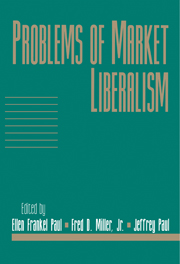Book contents
- Frontmatter
- Contents
- Introduction
- Acknowledgments
- Contributors
- Why All Welfare States (Including Laissez-Faire Ones) Are Unreasonable
- Measuring Opportunity: Toward a Contractarian Measure of Individual Interest
- Deontic Restrictions Are Not Agent-Relative Restrictions
- Why Even Egalitarians Should Favor Market Health Insurance
- Affirmative Action and the Demands of Justice
- The Dual Role of Property Rights in Protecting Broadcast Speech
- Regulation of Foods and Drugs and Libertarian Ideals: Perspectives of a Fellow-Traveler
- Profit: The Concept and Its Moral Features
- Natural Property Rights: Where They Fail
- Toward a Libertarian Theory of Class
- Libertarianism as if (the Other 99 Percent of) People Mattered
- On the Failure of Libertarianism to Capture the Popular Imagination
- Imitations of Libertarian Thought
- Index
Imitations of Libertarian Thought
Published online by Cambridge University Press: 26 January 2010
- Frontmatter
- Contents
- Introduction
- Acknowledgments
- Contributors
- Why All Welfare States (Including Laissez-Faire Ones) Are Unreasonable
- Measuring Opportunity: Toward a Contractarian Measure of Individual Interest
- Deontic Restrictions Are Not Agent-Relative Restrictions
- Why Even Egalitarians Should Favor Market Health Insurance
- Affirmative Action and the Demands of Justice
- The Dual Role of Property Rights in Protecting Broadcast Speech
- Regulation of Foods and Drugs and Libertarian Ideals: Perspectives of a Fellow-Traveler
- Profit: The Concept and Its Moral Features
- Natural Property Rights: Where They Fail
- Toward a Libertarian Theory of Class
- Libertarianism as if (the Other 99 Percent of) People Mattered
- On the Failure of Libertarianism to Capture the Popular Imagination
- Imitations of Libertarian Thought
- Index
Summary
IMITATION OR CONFUSION?
Imitation is said to be the sincerest form of flattery. Socially, the proposition may well be true. But in the world of ideas it is false: to the extent that two incompatible traditions use the same words or symbols to articulate different visions of legal or social organization, imitation begets confusion, not enlightenment. The effects of that confusion, moreover, are not confined to the world of ideas, but spill over into the world of politics and public affairs. Words are more than tools of description: they work also as tools of persuasion and transformation. Let a term have a favorable connotation in one context, and its imitative use can mislead people into thinking that a major departure from established practice is merely the extension or updating of an old principle to deal with new circumstances.
The risk of confusion born of imitation is familiar within the law. It is precisely to combat the dangers of confusion between rival firms and rival products that the law of trademarks and trade names grants exclusive rights in perpetuity to the creator of the name or the mark. The losses from confusion, moreover, are not confined to the holder of the name or the mark. Some losses are also borne by consumers, present and future, who now find it more costly to distinguish the real article from its substitutes. Even if these rival goods are not inferior–and imitative goods often are–the inability to distinguish goods by source allows the new entrant to free-ride on the name, mark, reputation, and advertising of the established firm.
- Type
- Chapter
- Information
- Problems of Market Liberalism , pp. 412 - 436Publisher: Cambridge University PressPrint publication year: 1998



